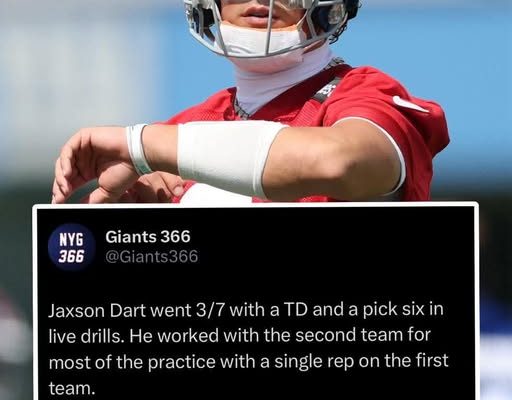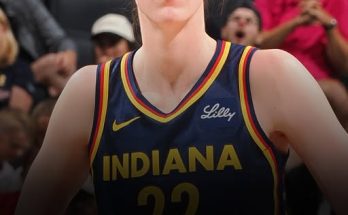In the unforgiving crucible of the NFL, where mere milliseconds and inches often dictate the outcome of high-stakes contests, the quarterback stands as the undeniable orchestrator, the focal point around which all offensive motion revolves. It’s a position that demands not only exceptional physical prowess but also an astute football IQ, the ability to process information at lightning speed, and an unyielding mental fortitude. For a burgeoning talent like Jaxson Dart, the path to becoming an elite NFL quarterback isn’t paved with highlight reels alone; it’s meticulously sculpted on the practice field, a relentless pursuit of perfection where every rep, every throw, and every decision is a brushstroke on the canvas of his potential.
The narrative surrounding Jaxson Dart often gravitates towards his prodigious arm talent. Indeed, he possesses a cannon for an arm, a natural gift that allows him to uncork deep throws with effortless velocity, slicing through wind and defensive schemes with an almost artistic precision. We’ve seen the viral lake passes and the impressive throws in offseason workouts that have set social media ablaze, igniting hope and speculation among fans and analysts alike. But in the nuanced world of professional football, a strong arm is merely a foundational stone, not the entire edifice. True mastery, the kind that translates into consistent NFL success, demands a far more holistic approach. For Dart, this understanding has become a guiding principle: practice isn’t just about showcasing his arm; it’s the ultimate testing ground where he hones that strength, refines his mechanics, and, critically, learns to outsmart the intricate defensive minds of the NFL.
The Symphony of Arm Strength: Beyond the Raw Power
While Dart’s inherent arm strength is undeniable, the journey to optimize it for NFL play is complex. It’s not just about how far he can throw the ball, but how accurately he can deliver it under duress, how consistently he can hit tight windows, and how well he can manipulate its trajectory to evade lurking defenders. This involves a multifaceted approach that extends far beyond simply “throwing hard.”
Firstly, there’s the relentless focus on biomechanics and throwing motion. Even the most powerful arm can be inefficient if the throwing mechanics are flawed. NFL coaching staffs meticulously analyze every aspect of a quarterback’s motion, from their footwork and hip rotation to their shoulder alignment and release point. The goal is to create a kinetic chain that efficiently transfers energy from the ground up, culminating in a whip-like force through the arm and hand. Dart, under the tutelage of experienced NFL quarterback coaches, is constantly refining these minute details. Drills like the “Snap and Throw” emphasize the connection with the center and a swift, decisive release. “Knee drills,” where the quarterback throws from a kneeling position, strip away leg drive, forcing a concentrated effort on core and arm muscle engagement, promoting better understanding and improvement of the upper body throwing motion. “Crossbar drills” teach proper arm extension and a high release point, ensuring the ball skims over defenders rather than into them. These are not merely exercises in brute force; they are precision movements designed to maximize velocity and accuracy simultaneously, transforming raw power into controlled precision.
Secondly, the development of arm strength in the NFL is deeply intertwined with a comprehensive strength and conditioning program. It’s not just about the arm itself, but the entire body. A strong core is paramount, acting as the bridge between the lower and upper body, transferring rotational power essential for throwing. Exercises like planks, Russian twists, and medicine ball slams are critical for developing this core stability and explosive power. Furthermore, attention is paid to the supporting muscle groups: the shoulders, triceps, forearms, and grip. Band triceps pushdowns, rows, shrugs, and dead hangs all contribute to building the necessary strength and resilience to withstand the repetitive stress of throwing an NFL-caliber football. Long toss regimens, where the quarterback progressively increases throwing distance, are also a staple, building endurance and arm recovery, allowing for consistent velocity throughout a demanding game. It’s a holistic approach that ensures Dart’s arm isn’t an isolated weapon but an integrated component of a powerful, athletic system.
The Chess Match: Outsmarting NFL Defenders
Possessing a strong arm is one thing; using it effectively against the complex, sophisticated defenses of the NFL is entirely another. This is where Dart’s embrace of practice as the ultimate testing ground truly shines. NFL defenders are not static cones; they are highly intelligent, supremely athletic individuals trained to disguise coverages, anticipate routes, and create chaos in the pocket. Outsmarting them requires an intimate understanding of defensive schemes, a mastery of pre-snap and post-snap reads, and the mental agility to adjust on the fly.
Reading the Defense: A Quarterback’s Rosetta Stone
The ability to accurately read a defense pre-snap is perhaps the most crucial skill for an NFL quarterback. It’s about quickly identifying the defensive alignment, the number of safeties, the potential blitzers, and the likely coverage. Dart is spending countless hours immersed in film study, learning the tells and tendencies of various defensive coordinators and players. He’s observing:
- Safety Alignment: Are there one or two safeties deep? This often dictates man-to-man (Cover 0 or Cover 1) versus zone coverage (Cover 2, Cover 3, Cover 4). A single high safety might suggest a blitz or man coverage underneath, while two high safeties often point to zone coverage, forcing throws into tighter windows.
- Linebacker Depth and Movement: Are linebackers creeping up to the line of scrimmage, indicating a blitz? Are they dropping into specific zones? Their initial alignment can reveal a lot about their responsibilities.
- Cornerback Leverage: Are corners playing inside or outside leverage? Are they pressed up on receivers or playing off? This can hint at man coverage, press coverage, or different types of zone.
The practice field allows Dart to translate this theoretical knowledge into practical application. During 7-on-7 drills and team periods, he’s actively making these reads, identifying defensive structures, and anticipating rotations. He’s learning to process information at game speed, a crucial skill that can only be developed through high-volume repetitions against live, intelligent opponents.
Post-Snap Adjustments: The Art of Improv
Even with a perfect pre-snap read, defenses are designed to evolve post-snap. Safeties rotate, linebackers drop, and corners bail, all in an effort to confuse the quarterback and disrupt passing lanes. This is where the mental aspect of the game becomes paramount. Dart is diligently working on:
- Pocket Presence and Movement: The ability to feel pressure, subtly shift within the pocket, and keep his eyes downfield is vital. This isn’t about running away from pressure but rather navigating it to buy more time for throws. Drills like the “Brady drill” and “Pocket Movement and Escape” are designed to hone these instincts, teaching quarterbacks to slide, step up, and reset their feet while maintaining an awareness of the developing play.
- Scanning and Progression Reads: Once the ball is snapped, Dart must swiftly scan through his receiver progressions, moving from his primary read to his secondary, tertiary, and so on. This requires discipline and the ability to quickly confirm or eliminate options based on how the defense reacts. Practice reps allow him to build this muscle memory, ensuring he doesn’t get locked onto one receiver but instead surveys the entire field.
- Anticipation Throws: The strong arm allows for it, but anticipation is what truly unlocks its potential. Throwing receivers open before they even make their break, delivering the ball to a spot where only the receiver can get it, and recognizing leverage advantages are hallmarks of elite NFL quarterbacks. This comes from countless reps, understanding route concepts, and building an almost telepathic connection with his pass-catchers.
The Unsung Hero: The Value of Repetitions
It cannot be overstated: the bedrock of Jaxson Dart’s development, and indeed any NFL player’s, is the sheer volume of high-quality repetitions. Practice isn’t merely a rehearsal; it’s a laboratory where skills are forged, mistakes are dissected, and lessons are internalized.
Every throw in practice, whether a perfect spiral or an errant pass, is an opportunity for learning. Coaches provide immediate feedback, allowing Dart to make real-time adjustments. He’s working through every offensive concept, against every defensive look imaginable. This relentless pursuit of reps leads to:
- Muscle Memory and Instinct: The more times Dart executes a specific movement or makes a specific read, the more ingrained it becomes. This allows him to react instinctively in game situations, freeing up mental processing power for more complex decisions.
- Timing and Chemistry: Developing seamless timing with receivers, understanding their stride, and anticipating their breaks can only come from thousands of throws together. Practice allows for this organic development of chemistry, crucial for converting throws into completions.
- Confidence Under Pressure: By consistently performing in a controlled but competitive environment, Dart builds confidence in his abilities. He learns to trust his arm, his reads, and his decision-making, even when the pressure is intense. The moments where he throws an interception in practice, as reportedly happened in an early camp session, are not failures but invaluable learning opportunities. As Russell Wilson reportedly advised him, “focus on the next play.” This mental resilience is cultivated through repeated exposure to challenges and the iterative process of learning and improving.
- Adaptability: NFL defenses constantly evolve, and what worked last week might not work this week. Through varied practice scenarios and scout team simulations, Dart is exposed to a wide array of defensive schemes, forcing him to adapt his approach and broaden his understanding. This adaptability is critical for long-term success in the league.
Technology as an Ally in the Practice Arena
The modern NFL practice field is not just about cones and drills; it’s increasingly augmented by cutting-edge technology. Jaxson Dart is likely leveraging these tools to accelerate his development:
- Virtual Reality (VR) Training: As seen with other rising stars, VR systems allow quarterbacks to step into simulated game environments without the physical toll of live reps. Dart can virtually relive past plays, rehearse against opponent-specific defensive tendencies, and practice reads from his own perspective. This immersive experience allows for countless mental reps, sharpening his decision-making and anticipation skills in a low-risk setting. The ability to pause, rewind, and analyze decisions in a 360-degree environment provides an unprecedented level of detail in learning.
- High-Speed Cameras and Biomechanical Analysis: These tools break down every aspect of Dart’s throwing motion, identifying inefficiencies or potential injury risks. Data points on release velocity, spin rate, and trajectory provide objective feedback, guiding his adjustments and ensuring he maximizes his arm talent safely and effectively.
- GPS Tracking and Wearable Technology: While perhaps more focused on physical conditioning, these technologies can track movement patterns, explosive bursts, and recovery metrics, allowing coaches to optimize Dart’s training load and prevent overtraining, ensuring he’s fresh and performing at his peak when it matters most.
The Mental Game: The Unseen Grind
Beyond the physical and tactical elements, the mental game is an inseparable part of a quarterback’s development, especially for a young player entering the intense scrutiny of the NFL. Practice provides the ideal environment to cultivate mental toughness.
- Processing Speed: The NFL game moves at an astonishing pace. Practice, particularly competitive drills and simulated game scenarios, forces Dart to make rapid decisions under pressure, improving his processing speed and reducing hesitation.
- Resilience and Short-Term Memory: Mistakes are inevitable. The ability to shake off a bad throw or a misread and immediately focus on the next play is a hallmark of great quarterbacks. Practice instills this resilience, teaching him to compartmentalize and move forward.
- Leadership and Communication: While not directly tied to arm strength, a quarterback’s ability to lead and communicate effectively with his teammates is crucial for success. Practice huddles, play calls, and on-field adjustments all serve as opportunities for Dart to hone his leadership skills and build rapport with his offensive unit.
Historical Precedent: The Practice-Forged Greats
History is replete with examples of NFL quarterbacks who, despite possessing varying degrees of raw talent, elevated their game through an unwavering commitment to practice and continuous refinement. While every player’s journey is unique, the common thread is often the understanding that success is not accidental but meticulously built, rep by rep. Quarterbacks known for their incredible consistency and longevity often cite their dedication to the practice field as a cornerstone of their careers. They didn’t just show up on Sundays; they meticulously prepared every day of the week, viewing practice as an extension of the game itself. Their pursuit of perfection in the details, their constant communication with coaches and teammates, and their unwavering focus on mastering the intricacies of their craft allowed them to outlast and outperform their peers. For Jaxson Dart, he’s undoubtedly studying these legends, drawing inspiration from their work ethic, and understanding that his future in the NFL will be a direct reflection of the effort he pours into his daily grind.
In conclusion, Jaxson Dart’s burgeoning NFL career is a testament to the fact that raw talent, while a fantastic starting point, is only one piece of the puzzle. His impressive arm strength is certainly a gift, a tool that opens up a myriad of offensive possibilities. However, it’s his astute recognition that the practice field is the ultimate laboratory for development that truly sets him apart. It’s where he refines his mechanics, transforming power into precision; where he dissects defensive schemes, turning anticipation into advantage; and where he cultivates the mental fortitude necessary to navigate the relentless pressures of the NFL. Every drill, every repetition, every moment of self-correction in practice is a deliberate step towards outsmarting the league’s most formidable defenders. As Dart continues to embrace this philosophy, his journey promises to be not just about the throws he makes on Sundays, but the countless, unseen hours he dedicates to his craft, meticulously shaping himself into an NFL quarterback capable of truly leading his team to victory. The future is indeed bright for a player who understands that the ultimate testing ground for greatness is found in the relentless pursuit of perfection, one practice rep at a time.



